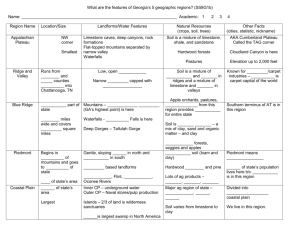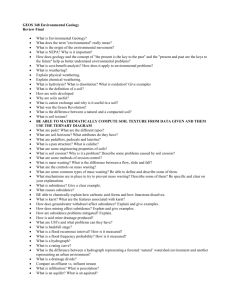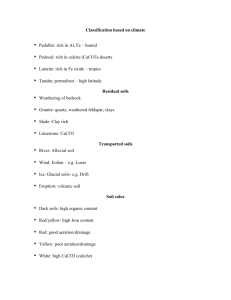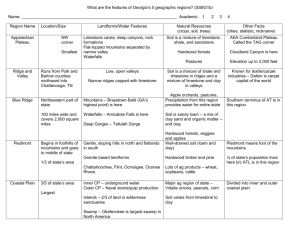Salt Lake Community College Geography 1700 – Physical Geography AJ
advertisement
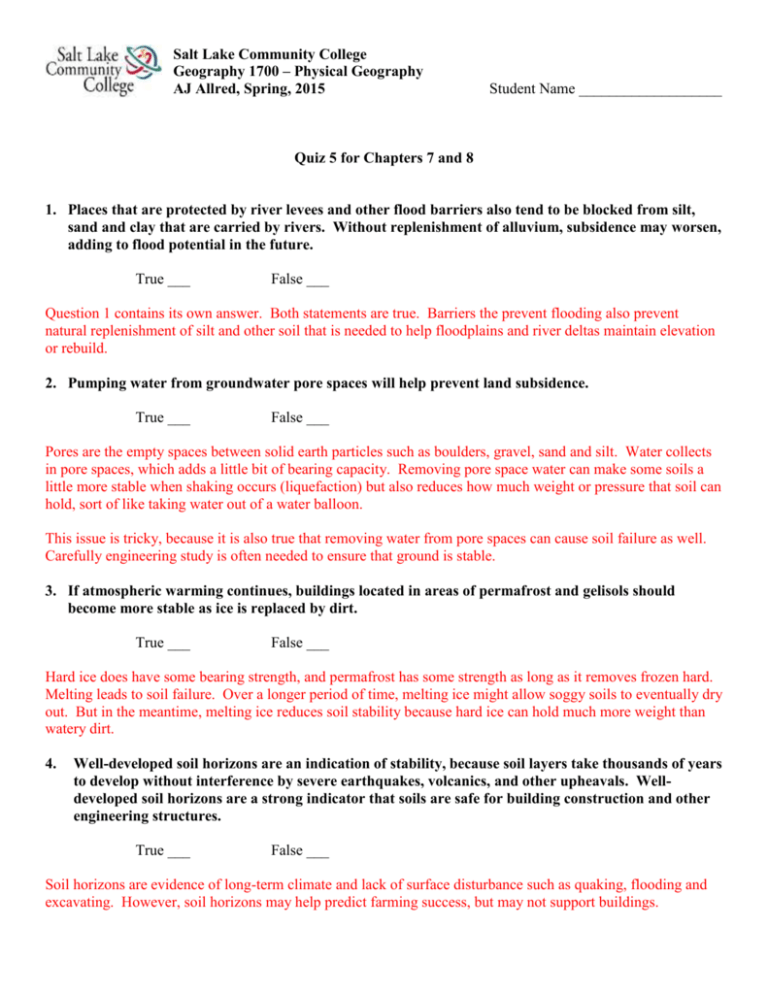
Salt Lake Community College Geography 1700 – Physical Geography AJ Allred, Spring, 2015 Student Name ___________________ Quiz 5 for Chapters 7 and 8 1. Places that are protected by river levees and other flood barriers also tend to be blocked from silt, sand and clay that are carried by rivers. Without replenishment of alluvium, subsidence may worsen, adding to flood potential in the future. True ___ False ___ Question 1 contains its own answer. Both statements are true. Barriers the prevent flooding also prevent natural replenishment of silt and other soil that is needed to help floodplains and river deltas maintain elevation or rebuild. 2. Pumping water from groundwater pore spaces will help prevent land subsidence. True ___ False ___ Pores are the empty spaces between solid earth particles such as boulders, gravel, sand and silt. Water collects in pore spaces, which adds a little bit of bearing capacity. Removing pore space water can make some soils a little more stable when shaking occurs (liquefaction) but also reduces how much weight or pressure that soil can hold, sort of like taking water out of a water balloon. This issue is tricky, because it is also true that removing water from pore spaces can cause soil failure as well. Carefully engineering study is often needed to ensure that ground is stable. 3. If atmospheric warming continues, buildings located in areas of permafrost and gelisols should become more stable as ice is replaced by dirt. True ___ False ___ Hard ice does have some bearing strength, and permafrost has some strength as long as it removes frozen hard. Melting leads to soil failure. Over a longer period of time, melting ice might allow soggy soils to eventually dry out. But in the meantime, melting ice reduces soil stability because hard ice can hold much more weight than watery dirt. 4. Well-developed soil horizons are an indication of stability, because soil layers take thousands of years to develop without interference by severe earthquakes, volcanics, and other upheavals. Welldeveloped soil horizons are a strong indicator that soils are safe for building construction and other engineering structures. True ___ False ___ Soil horizons are evidence of long-term climate and lack of surface disturbance such as quaking, flooding and excavating. However, soil horizons may help predict farming success, but may not support buildings. The key here is that stable farm soils are not necessarily stable building soils. Supporting healthy farm plants is not the same as supporting heavy buildings. 5. Mild carbonic acid easily erodes limestone formations that cover about 10 percent of Earth’s surface. Carbonic acid is formed by rainwater and atmospheric carbon dioxide. True ___ False ___ Above ground, limestone is a durable building material. Underground, persist mild acidity quickly dissolves limestone, causing rock failure. Karst country covers about 10% of Earth’s surface, and caves and “cave-ins” are common, leading to lumpy surfaces. In the modern world, atmospheric acidity is rising enough that even durable limestone structures are dissolving. This is especially true in large cities where air pollution adds to atmospheric acidity. 6. Silt is fine-grained material that is wind-blown into fairly deep or thick formations. People often carve caves in these loess deposits, and often live there successfully for hundreds or even thousands of years. True ___ False ___ Strangely enough, piles of wind-blow, fine-grain silt can actually pack down well enough to support carved interiors and road cuts that stand up to weather. Millions of people still occupy hand-made caves in silt formations. However, once in a while, a combination of excessive water and/or earthquake shaking can cause catastrophic failure of loee (silt) formations. 7. Mass wasting and land subsidence are closely related sets of hazards that share much of the same science and terminology; however, mass wasting includes more events that kill quickly while subsidence includes more processes that cause slow but substantial financial loss. True ___ False ___ All true. 8. Clay is very dense earth material that is quite hard when dry. Installation of perimeter drains makes clay an excellent foundation material for building construction. True ___ False ___ It is very difficult to keep clay dry, even with perimeter drains. The general rule is to avoid clay. Even farmers find it very difficult to work with clay, because it is either too sticky when wet, or too hard when dry. Clay is the best example of expansive soils or “shrink-swell” soils. Vertical deformation is the major result: clay expands and lifts by absorbing water, and then shrinks and collapses when dried-out. 9. Subsidence is a sudden drop in groundwater level that is a frequent precursor to an earthquake. Still, precursors and fore shocks are considered unreliable for forecasting. True ___ False ___ Subsidence can occur for many reasons, and a sudden drop in ground level might sometimes be a quake precursor. However, a sudden change in ground water is not known as an indicator of a forthcoming earthquake. 10. Which of the following materials is most associated with expansive soils? a. Clay b. Lava and other volcanic deposits c. Rock salt d. Limestone e. Granite See Question 8. Also, lava, limestone, salt and granite do not swell by absorbing water. Instead, most of them tend to collapse or fail when subjected to water over time. Among all of the answers above, only clay is expansive, meaning that it swells when wet. 11. The Mississippi River delta contains the out wash or alluvium from eroding farm lands. Around the world, millions of people rely on farming in river deltas where downstream flooding and upstream inundation are a constant threat. True ___ False ___ All is true in Question 11. 12. Coal mining in Utah causes soil failures on the surface and lethal danger to miners deep underground. Coal reserves are often “sterilized” or unusable forever because previous mining has made the ground too unstable for more extraction. Coal from Utah’s Skyline mine helps generate electricity at Utah’s Hunter power plant. That power plant requires water from nearby Electric Lake. Unfortunately, lake water percolates into Skyline mine and must be pumped out using electricity from the power plant. So, ironically, Skyline mine must use its own coal to pump out the same intruding lake water over and over. . True ___ False ___ Everything in Question 12 is true. Coal mining in Utah and around the world is a great example of humaninduced earth failure. Skyline has the added problem having to use some of its own coal to pump out leaking water that results from a lake that was created to support power generation. 13. People benefit from activities that also cause soil failure and billions of dollars in financial losses. True ___ False ___ People do things for a reason. We just don’t always think about the consequences or side effects of what we do. Billions in financial loss could be prevented, but we would also lose billions of dollars in economic gain that also result from activities that contribute to hazards, disasters and catastrophes. 14. Experiences learned from the nuclear disaster in Fukushima, Japan now ensure that such disasters will never occur again anywhere, because ____________________. a. we now know how high to build walls that block tsunami waves b. the Japanese have built barriers that can resist any ocean wave c. other countries have learned from the Japanese experience, and vulnerable buildings such as nuclear power plants have been moved back from coastal areas d. All of the above explain why disasters like Fukushima will never happen again. Still, other hazards at nuclear plants remain to be solved e. None of the statements in Question 14 above are true. It is not true that all nuclear power plants are safe. They tend to be located near large supplies of water that are needed for cooling. So, water intrusion will always be a threat. We have learned a lot about how to calculate the necessary height of a flood-prevention wall, but we don’t know everything, and we certainly haven’t retrofitted walls to safer height. In most cases, we just don’t want to spend that much money. As far as I know, no power plants have been relocated. .No one has that much money. 15. It is true that many topics in Geography 1700 are unpleasant and sometimes frustrating. It is easy to feel cynical or jaded about human activities and natural hazards. However, it is also true that focusing on the bad news is really evidence that human societies are making great progress in preventing death and financial loss. In fact, it is true that “forewarned is often forearmed”. True ___ False ____ Everything in Question 15 is supported by the textbook and class discussion. 16. It is much better to read about disasters than to experience them. That is the value of Geography 1700 and general education at SLCC. Humans are gamblers, but we are winning more and more often. We really do have the power to make good decisions. Now, please put down that pizza and vote for a tax increase to pay for better disaster planning! True ___ False ___ The world is a much safer place than in generations past, because we often apply what we have learned. However, with billions more people living on Earth than in the past, it is harder to find safe locations. Human activities are also much more destructive than in the past. We have enough energy to move whole mountains, and we also apparently have enough energy to alter Earth’s atmosphere, leading to gradual, but powerful changes in climate. Rising sea levels are expected to cause vast damage to coastlines and cities in the future. Humans are gamblers in every sense, and we keep gambling because we tend to win most of the time. Unfortunately, the losers are often not available to tell us their regrets. Dead people can’t share their experiences with us, so we take Geography 1700 instead. 17. Which of the following is a valid human benefit created by karst formations? a. Caves create interesting landscapes. b. Sinkholes might help get rid of a neighbor you don’t like. c. Sink holes and karst activity produce limestone bedrock that is a popular and durable building material as long as it is not exposed to excessive amounts of carbonic acid d. Karst formations provide temporary shelter for millions of poor people who find it easy to carve loess (silt). Karst housing made of silt is not safe for long-term occupancy. e. All of the above are good reasons for approving human dwellings in karst country. Caves are interesting and we learn a lot by going underground. All of the other answers are not reasonable. Karst activity does not produce limestone, it dissolves limestone. Not many people live in karst caves, but in loess or silt caves. People don’t carve caves in limestone, but in silt. Karst is made of limestone, not silt. 18. Expansive soils (swelling soils) cause less overall damage than do shrinking soils. True ___ False ___ It is not possible to separate swell from shrink because they both go together. Soils that swell eventually shrink, and both movements cause soil failure and damage to human structures. 19. The problem with permafrost soils is not that they melt completely but that they shrink in volume when they freeze hard during the coldest parts of winter. In warmer weather they do swell enough to fill gaps and prevent most episodes of building collapse. True ___ False ___ Water expands rather than shrinks when it freezes. Frozen soil shrinks and collapses when melting. 20. Leaving the sprinkler on too long can cause slow, but serious foundation damage underneath buildings. True ___ False ___ All true. 21. Steep terrain enhances the effect of many soil failure hazards. Very flat terrain also enhances the effect of many drainage problems. It is getting harder to find good building sites in the United States and around the world. True ___ False ___ All true. In Utah, California and countless other places, people really do want to live up on the hill. Even if they didn’t, it is getting harder to find building sites that are on ground that is not too steep, and not too flat. Water causes problems on steep ground, and on very flat ground. Well-drained, stable sites in between are getting harder to find. 22. Which terrain or earth type is most appropriate for a percolation test pit? a. Steep and rocky b. Very flat c. Clay soil d. Sandy soil e. Porous volcanic bedrock Clay is the key word in this question. Clay shrinks and swells by water and is the most common condition that calls for testing how quickly water will drain away. Very flat soil will not drain surface water easily, but if clay is not present, then a percolation test may not be needed either. Sandy soil and porous rocks drain easily. 23. Which of the following changes could turn an earth “slump” into an “earth flow” is by _______________. a. b. c. d. e. increasing slope steepness adding water reducing the size of particles in the soil shaking or vibration Adding water is the most direct approach, but all of the above contribute to a slump becoming a flow. Throughout Geography 1700 we have emphasized the importance of water. Water is the most common and simple way to de-stabilize earth. Of course, we can’t change particle size, but humans and earthquakes definitely increase the likelihood of liquefaction occurring. Shaking causes water surface tension to break, and shaking also breaks down the friction between soil particles. Once they start moving, it is hard to get that stickiness or friction to re-establish. Adding water is a very easy way to break down or remove soil strength: water is lubrication and water tends to actually chemically dissolve almost everything it touches. 24. Proper compaction of soils around structures is essential for building durability. At the same time, heavily compacted soils may not drain properly. So, the correct design may require expensive engineering study. True ___ False ___ Both of these statements are true and can be confusing. On one hand, soils are stronger when they are compacted under and around buildings and structures. However, very compacted soils can be so tight that water can’t drain out of them. That is why “engineered fill” material is often brought in because it compacts well for strength, but still drains well enough to prevent soils from dissolving or being slippery. 25. Region-wide subsidence has been severe in many farm areas where groundwater is essential for crop production. In some places like South Texas, subsidence is even worse because oil, gas and salt have also been removed from the ground. Sub-surface sea water intrusion is an increasing problem, .and someday surface sea water inundation will likely occur as well. True ___ False ___ Water is not a bearing surface, but it does take up space and has weight, so removing water from soil tends to make soils subside to fill up the empty space. Water pressure underground can drop when pumping occurs, so the pressure of nearby sea water can push in to take the place of fresh water that is lost. Places like South Texas are losing groundwater for urban use and farming. Pumping oil and gas from the ground adds to the problem of subsidence and salt water intrusion. Pumping out dissolved salt formations is yet another problem along the Gulf Coast. 26. The lethal “rock fall” that occurred in Rockville, Utah ______________________. a. is a known hazard for which there are preventive solution b. has a proven history of dangerous events in the past c. is an example of how people in both rich and poor nations often claim that they have “no place else to go” d. will probably kill people again someday e. All of the above are true of Rockville, Utah. Even the name of the town tells you something important. The 3rd edition of our class textbook used Rockville, Utah as an example of a town that needs better planning. Since that time, people have died from that same unresolved problem. Everything in Question 26 is true. 27. Motor fuel prices in Utah have dropped drastically in the past year because ____________. a. improvements in “best practices” prevent soil subsidence in most cases. b. we no longer allow soil subsidence, water contamination and other problems to result from pumping gas and oil from the ground c. “fracking” technology increases oil and gas yields without environmental degradation d. new”fracking” technology increases the quantity of resource extraction while also causing alleged water contamination, soil instability and even small earthquakes. e. All of the above explain why motor fuel prices are very low lately. Absolute proof is often impossible, but growing evidence indicates that pumping fluids in and out of the ground to loosen and remove oil and gas is causing major rock failures. In fact, the whole idea of “fracking” is associated with fracturing. In any case, the mere fact that we are removing billions of cubic feet of gas and oil from the ground leaves voids that can be filled by rock and soil failure. Gases and fluids don’t always come out where we can collect them. They may leak out elsewhere, causing serious environmental problems. 28. The use of “drain tile” or other kinds of underground perforated pipe may not only help keep excess water away from buildings, but may also collect and remove radon gas that is the second-leading cause of lung cancer in Utah and/or the United States. True ___ False ___ Perforated pipe (drain tile” does collect fluid for carriage somewhere else. Collection pipes can also remove dangerous radon gas that leaks out of the ground at many locations around the United States and Utah. Radon gas causes more lung cancer in Utah than anything else except smoking. 29. Severe soil acidity can damage limestone bedrock as well as concrete building foundations because both are composed of minerals that are vulnerable to a pH number somewhere above 10 or 11 (on a scale of 1 to 14). True ___ False ___ Everything in Question 29 is true except that acidity is represented by pH scale numbers smaller than 7.0. Numbers higher than 7.0 are alkaline, or basic, which is the opposite of acidity. Portland cement in concrete is made from limestone, and both are dissolved by acidity. 30. The broad Mississippi River delta is a good example of how much farm soil is being eroded in the United States. Farm practices have improved greatly, but intensive crop production still results in vast erosion of some of the world’s best farm soils. In a very real sense, food production is “mining” farm soil that will take thousands of years to replace by natural processes. True ___ False ___ Erosion occurs with or without people. However, aggressive farming for high yield and profits puts great stress on American’s great farm soils. Erosion occurs more quickly when soils are tilled constantly and the muddy Mississippi River is carrying millions of tons of excellent farm soil out to the sea. We “mine” coal, oil and gas and then it is gone. In a real sense, over-aggressive farming causes soil loss, as if it were being mined-out.
